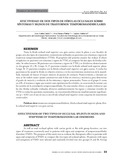| dc.rights.license | http://creativecommons.org/licenses/by-nc-sa/3.0/ve/ | |
| dc.contributor.author | Terán, Ana Adela | |
| dc.contributor.author | Fleitas, Ana T. | |
| dc.contributor.author | Arellano G., Leylan A. | |
| dc.date.accessioned | 2011-10-27T16:38:14Z | |
| dc.date.available | 2011-10-27T16:38:14Z | |
| dc.date.issued | 2011-10-27T16:38:14Z | |
| dc.identifier.issn | 1856-3201 | es_VE |
| dc.identifier.uri | http://www.saber.ula.ve/handle/123456789/33984 | |
| dc.description.abstract | Tanto la férula oclusal total superior con guía canina como la plana o con función de grupo, son dos tipos de tratamiento comúnmente utilizados en
pacientes con síntomas y signos de trastornos temporomandibulares (TTM). El propósito del presente estudio fue evaluar el efecto terapéutico en pacientes
con síntomas y signos de TTM, al comparar los dos tipos de férulas oclusales. Se seleccionaron 30 pacientes con síntomas y signos de TTM y se dividieron
aleatoriamente en dos grupos (A y B). Grupo A: 15 pacientes tratados con la férula oclusal total superior plana. Grupo B: 15 pacientes tratados con la
férula oclusal total superior con guía canina. A todos los pacientes se les ajustó la férula en relación céntrica y en los movimientos excéntricos de la
mandíbula, tratando de buscar el mayor número de puntos de contacto. Posteriormente, y durante un mes, se les realizó cuatro ajustes consecutivos cada 8
días en céntrica y excéntrica, para determinar el grado de mejoría y evolución de los síntomas y signos presentados. Tanto en el grupo A como en el B, el
síntoma o signo que remitió más rápidamente fue el dolor, no ocurriendo lo mismo con los sonidos de la articulación temporomandibular. En este estudio
clínico se pudo evidenciar que las dos férulas oclusales evaluadas aliviaron satisfactoriamente los signos y síntomas iniciales de TTM en todos los
pacientes examinados, no encontrando diferencias estadísticamente significativas (p > 0.05) con el uso de una u otra férula oclusal total superior como esquema de tratamiento conservador. | es_VE |
| dc.language.iso | es | es_VE |
| dc.rights | info:eu-repo/semantics/openAccess | |
| dc.subject | Trastornos temporomandibulares | es_VE |
| dc.subject | Férula oclusal total superior plana | es_VE |
| dc.subject | Férula oclusal total superior con guía canina | es_VE |
| dc.title | Efectividad de dos tipos de férulas oclusales en síntomas y signos de trastorno temporomandibulares | es_VE |
| dc.title.alternative | Effectiveness of two types of occlusal splints in signs and symptoms of temporomandibular disorder | es_VE |
| dc.type | info:eu-repo/semantics/article | |
| dc.description.abstract1 | As well as total occlusal splints with canine guide or flat with group function, are two types of treatment commonly used in patients with signs and
symptoms of temporomandibular disorders (TMD). The purpose of this study was to evaluate the therapeutic effect in patients with signs and symptoms of TMD,
to compare the two types of occlusal splints. 30 patients with signs and symptoms of TMD were selected and randomly divided into two groups (A and B).
Group A: 15 patients were treated with flat total occlusal splint. Group B: 15 patients were treated with total occlusal splint with canine guide. All
splints were adjusted in centric relation and eccentric movements of the jaw to all patients, trying to find the highest number of contact points. Later,
four consecutive adjustments were made every 8 days in centric and eccentric, to determine the degree of improvement and evolution of signs and symptoms
presented. In Group A as well as group B, the sign and symptom that disappear more quickly was pain, not happening the same with sounds of the
temporomandibular joint. In this trial it could be demonstrate that the two evaluated occlusal splints successfully relieved initial signs and symptoms of
TMD in all patients examined, demonstrated that there is no statistically significant difference (p > 0.05) with the use of one or another total occlusal splint as conservative treatment scheme. | es_VE |
| dc.description.colacion | 33-41 | es_VE |
| dc.description.email | anateresafleitas@yahoo.es | es_VE |
| dc.description.email | leylan_are@yahoo.es | es_VE |
| dc.description.email | leylan@ula.ve | es_VE |
| dc.identifier.depositolegal | PP200502ME2052 | es_VE |
| dc.subject.facultad | Facultad de Odontología | es_VE |
| dc.subject.keywords | Temporomandibular disorders | es_VE |
| dc.subject.keywords | Total occlusal splints with canine guide | es_VE |
| dc.subject.keywords | Total occlusal flat splint | es_VE |
| dc.subject.publicacionelectronica | Revista Odontológica de Los Andes | es_VE |
| dc.subject.seccion | Revista Odontológica de Los Andes: Trabajos de Investigación | es_VE |
| dc.subject.thematiccategory | Medicina y Salud | es_VE |
| dc.subject.tipo | Revistas | es_VE |
| dc.type.media | Texto | es_VE |


